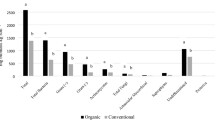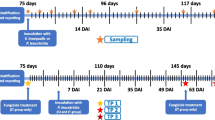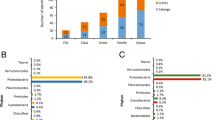Abstract
Huanglongbing (HLB), caused by Candidatus Liberibacter asiaticus (CLas), an uncultured α-proteobacterium, is the most destructive disease of citrus trees worldwide. In previous studies, trunk injections of penicillin reduced CLas titers and HLB symptoms in citrus. However, antibiotic effects on the whole plant microbial community, which include effects on taxa that interact with CLas, have not yet been addressed. In this study, we investigated the effects of penicillin injection (0, 1000, and 6000 mg L−1) on rhizospheric and endophytic bacterial communities of grapefruit trees in field and greenhouse experiments through culture-independent high-throughput sequencing. DNA extractions from petioles and roots were subjected to 16S rRNA high-throughput sequencing, and reads were clustered by sequence similarity into operational taxonomic units (OTUs). Principal coordinates analysis based on weighted-UniFrac distances did not reveal differences in bacterial communities among treatments in any of the sample sources. However, pairwise linear discriminant analysis indicated significant differences in relative abundance of some taxa (including CLas) among treatments. Network analysis showed that penicillin produced major changes in root bacterial community structure by affecting interspecific microbial associations. This study provides new knowledge of the effect of antimicrobial treatments on interspecific relationships in citrus microbial communities.





Similar content being viewed by others
References
Bové JM (2006) Huanglongbing: a destructive, newly-emerging, century-old disease of citrus. J. Plant Pathol. 88(1):7–37
Farnsworth D, Grogan KA, van Bruggen AH, Moss CB (2014) The potential economic cost and response to greening in Florida citrus. Choices 29:1–6
da Graça JV, Douhan GW, Halbert SE, Keremane ML, Lee RF, Vidalakis G, Zhao H (2016) Huanglongbing: an overview of a complex pathosystem ravaging the world’s citrus. J. Integr. Plant Biol. 58:373–387. https://doi.org/10.1111/jipb.12437
Hodges AW, Spreen TH (2012) Economic impacts of citrus greening (HLB) in Florida, 2006/7–2010/11. University of Florida Department of Food and Resource Economics
NASS (2016) United States Department of Agriculture. Agricultural Marketing Service. National Agricultural Statistics Service. 2015–2016. Florida Citrus Statistics
Shimwela MM, Narouei-Khandan HA, Halbert SE, Keremane ML, Minsavage GV, Timilsina S, Massawe DP, Jones JB, van Bruggen AHC (2016) First occurrence of Diaphorina citri in East Africa, characterization of the Ca. Liberibacter species causing huanglongbing (HLB) in Tanzania, and potential further spread of D. citri and HLB in Africa and Europe. Eur. J. Plant Pathol. 146:349–368. https://doi.org/10.1007/s10658-016-0921-y
Boina DR, Bloomquist JR (2015) Chemical control of the Asian citrus psyllid and of huanglongbing disease in citrus. Pest Manag. Sci. 71:808–823. https://doi.org/10.1002/ps.3957
Shen W, Halbert SE, Dickstein E et al (2013) Occurrence and in-grove distribution of citrus huanglongbing in north central Florida. J. Plant Pathol.:361–371
Shen W, Cevallos-Cevallos JM, Da Rocha UN et al (2013) Relation between plant nutrition, hormones, insecticide applications, bacterial endophytes, and Candidatus Liberibacter Ct values in citrus trees infected with Huanglongbing. Eur. J. Plant Pathol. 137:727–742
McManus PS, Stockwell VO, Sundin GW, Jones AL (2002) Antibiotic use in plant agriculture. Annu. Rev. Phytopathol. 40:443–465. https://doi.org/10.1146/annurev.phyto.40.120301.093927
EPA (2013) Streptomycin; pesticide tolerances for emergency exemptions. Environmental Protection Agency 40 CFR Part 180 [EPA–HQ–OPP–2011–0852; FRL–9385–3]. Federal Register 78 (96):29049
Graham JH, Dewdney MM, Myers ME (2010) Streptomycin and copper formulations for control of citrus canker on grapefruit. Proc Fla State Hortic Soc 123:92–99
Zhang M, Guo Y, Powell CA, Doud MS, Yang C, Duan Y (2014) Effective antibiotics against ‘Candidatus Liberibacter asiaticus’ in HLB-affected citrus plants identified via the graft-based evaluation. PLoS One 9:e111032. https://doi.org/10.1371/journal.pone.0111032
Zhang M, Powell CA, Guo Y, Benyon L, Duan Y (2013) Characterization of the microbial community structure in Candidatus Liberibacter asiaticus-infected citrus plants treated with antibiotics in the field. BMC Microbiol. 13:112. https://doi.org/10.1186/1471-2180-13-112
Zhang M, Powell CA, Benyon LS, Zhou H, Duan Y (2013) Deciphering the bacterial microbiome of citrus plants in response to Candidatus Liberibacter asiaticus-infection and antibiotic treatments. PLoS One 8:e76331. https://doi.org/10.1371/journal.pone.0076331
Hu J, Jiang J, Wang N (2018) Control of citrus huanglongbing via trunk injection of plant defense activators and antibiotics. Phytopathology 108:186–195. https://doi.org/10.1094/PHYTO-05-17-0175-R
Buchholz A, Baur P, Schönherr J (1998) Differences among plant species in cuticular permeabilities and solute mobilities are not caused by differential size selectivities. Planta 206:322–328
Buchholz A, Schönherr J (2000) Thermodynamic analysis of diffusion of non-electrolytes across plant cuticles in the presence and absence of the plasticiser tributyl phosphate. Planta 212:103–111
Kumar K, C. Gupta S, Chander Y, Singh AK (2005) Antibiotic use in agriculture and its impact on the terrestrial environment. In: Advances in agronomy. Elsevier, pp 1–54
Stockwell VO, Duffy B (2012) Use of antibiotics in plant agriculture. Rev Sci Tech Int Off Epizoot 31:199–210
Chung K, Zhisheng W (1991) A study on the use of antibiotics to control citrus huanglongbing. Proceedings of the 6th international Asia Pacific Workshop on Integrated Health Management. FAO, Rome, pp 40–48
Aćimović SG, Zeng Q, McGhee GC et al (2015) Control of fire blight (Erwinia amylovora) on apple trees with trunk-injected plant resistance inducers and antibiotics and assessment of induction of pathogenesis-related protein genes. Front. Plant Sci. 6. https://doi.org/10.3389/fpls.2015.00016
Poudel R, Jumpponen A, Schlatter DC, Paulitz TC, Gardener BBMS, Kinkel LL, Garrett KA (2016) Microbiome networks: a systems framework for identifying candidate microbial assemblages for disease management. Phytopathology 106:1083–1096. https://doi.org/10.1094/PHYTO-02-16-0058-FI
Franklin AM, Aga DS, Cytryn E, Durso LM, McLain JE, Pruden A, Roberts MC, Rothrock MJ, Snow DD, Watson JE, Dungan RS (2016) Antibiotics in agroecosystems: introduction to the special section. J. Environ. Qual. 45:377. https://doi.org/10.2134/jeq2016.01.0023
Shin K, Ascunce MS, Narouei-Khandan HA, Sun X, Jones D, Kolawole OO, Goss EM, van Bruggen AHC (2016) Effects and side effects of penicillin injection in huanglongbing affected grapefruit trees. Crop Prot. 90:106–116. https://doi.org/10.1016/j.cropro.2016.08.025
Grünwald NJ, Hu S, van Bruggen AHC (2000) Short-term cover crop decomposition in organic and conventional soils: characterization of soil C, N, microbial and plant pathogen dynamics. Eur J Plant Pathol 106:37–50. https://doi.org/10.1023/A:1008720731062
Zelenev VV, van Bruggen AH, Semenov AM (2000) “BACWAVE,” a spatial-temporal model for traveling waves of bacterial populations in response to a moving carbon source in soil. Microb. Ecol. 40:260–272
Zelenev VV, van Bruggen AHC, Semenov AM (2005) Short-term wavelike dynamics of bacterial populations in response to nutrient input from fresh plant residues. Microb. Ecol. 49:83–93. https://doi.org/10.1007/s00248-003-1054-3
Yocum RR, Rasmussen JR, Strominger JL (1980) The mechanism of action of penicillin: penicillin acylates the active site of Bacillus stearothermophilus D-alanine carboxypeptidase. J. Biol. Chem. 255:3977–3986
Zhang Q, Dick WA (2014) Growth of soil bacteria, on penicillin and neomycin, not previously exposed to these antibiotics. Sci. Total Environ. 493:445–453. https://doi.org/10.1016/j.scitotenv.2014.05.114
Caporaso JG, Lauber CL, Walters WA, Berg-Lyons D, Lozupone CA, Turnbaugh PJ, Fierer N, Knight R (2011) Global patterns of 16S rRNA diversity at a depth of millions of sequences per sample. Proc. Natl. Acad. Sci. U. S. A. 108(Suppl 1):4516–4522. https://doi.org/10.1073/pnas.1000080107
Caporaso JG, Kuczynski J, Stombaugh J, Bittinger K, Bushman FD, Costello EK, Fierer N, Peña AG, Goodrich JK, Gordon JI, Huttley GA, Kelley ST, Knights D, Koenig JE, Ley RE, Lozupone CA, McDonald D, Muegge BD, Pirrung M, Reeder J, Sevinsky JR, Turnbaugh PJ, Walters WA, Widmann J, Yatsunenko T, Zaneveld J, Knight R (2010) QIIME allows analysis of high-throughput community sequencing data. Nat. Methods 7:335–336. https://doi.org/10.1038/nmeth.f.303
Rideout JR, He Y, Navas-Molina JA, Walters WA, Ursell LK, Gibbons SM, Chase J, McDonald D, Gonzalez A, Robbins-Pianka A, Clemente JC, Gilbert JA, Huse SM, Zhou HW, Knight R, Caporaso JG (2014) Subsampled open-reference clustering creates consistent, comprehensive OTU definitions and scales to billions of sequences. PeerJ 2:e545. https://doi.org/10.7717/peerj.545
Lozupone CA, Knight R (2005) UniFrac: a new phylogenetic method for comparing microbial communities. Appl. Environ. Microbiol. 71:8228–8235. https://doi.org/10.1128/AEM.71.12.8228-8235.2005
Lozupone CA, Hamady M, Kelley ST, Knight R (2007) Quantitative and qualitative diversity measures lead to different insights into factors that structure microbial communities. Appl. Environ. Microbiol. 73:1576–1585. https://doi.org/10.1128/AEM.01996-06
Segata N, Izard J, Waldron L, Gevers D, Miropolsky L, Garrett WS, Huttenhower C (2011) Metagenomic biomarker discovery and explanation. Genome Biol. 12:R60. https://doi.org/10.1186/gb-2011-12-6-r60
Friedman J, Alm EJ (2012) Inferring correlation networks from genomic survey data. PLoS Comput. Biol. 8:e1002687. https://doi.org/10.1371/journal.pcbi.1002687
Csardi G, Nepusz T (2006) The igraph software package for complex network research. InterJournal Complex Syst 1695:1–9
Core Team R (2016) R: a language and environment for statistical computing. R Foundation for Statistical Computing, Vienna
Nguyen NH, Smith D, Peay K, Kennedy P (2015) Parsing ecological signal from noise in next generation amplicon sequencing. New Phytol. 205:1389–1393. https://doi.org/10.1111/nph.12923
van der Heijden MGA, Hartmann M (2016) Networking in the plant microbiome. PLoS Biol. 14:e1002378. https://doi.org/10.1371/journal.pbio.1002378
Trivedi P, Duan Y, Wang N (2010) Huanglongbing, a systemic disease, restructures the bacterial community associated with citrus roots. Appl. Environ. Microbiol. 76:3427–3436. https://doi.org/10.1128/AEM.02901-09
Gourion B, Rossignol M, Vorholt JA (2006) A proteomic study of Methylobacterium extorquens reveals a response regulator essential for epiphytic growth. Proc. Natl. Acad. Sci. 103:13186–13191. https://doi.org/10.1073/pnas.0603530103
Meena KK, Sorty AM, Bitla UM, Choudhary K, Gupta P, Pareek A, Singh DP, Prabha R, Sahu PK, Gupta VK, Singh HB, Krishanani KK, Minhas PS (2017) Abiotic stress responses and microbe-mediated mitigation in plants: the omics strategies. Front. Plant Sci. 8. https://doi.org/10.3389/fpls.2017.00172
Boutin S, Bernatchez L, Audet C, Derôme N (2013) Network analysis highlights complex interactions between pathogen, host and commensal microbiota. PLoS One 8:e84772. https://doi.org/10.1371/journal.pone.0084772
Kyselková M, Kopecký J, Frapolli M, Défago G, Ságová-Marečková M, Grundmann GL, Moënne-Loccoz Y (2009) Comparison of rhizobacterial community composition in soil suppressive or conducive to tobacco black root rot disease. ISME J 3:1127–1138. https://doi.org/10.1038/ismej.2009.61
Adam M, Westphal A, Hallmann J, Heuer H (2014) Specific microbial attachment to root knot nematodes in suppressive soil. Appl. Environ. Microbiol. 80:2679–2686. https://doi.org/10.1128/AEM.03905-13
Madhaiyan M, Poonguzhali S, Lee J-S, Lee KC, Saravanan VS, Santhanakrishnan P (2010) Microbacterium azadirachtae sp. nov., a plant-growth-promoting actinobacterium isolated from the rhizoplane of neem seedlings. Int. J. Syst. Evol. Microbiol. 60:1687–1692. https://doi.org/10.1099/ijs.0.015800-0
Madigan MT, Martinko JM, Parker J (1997) Brock biology of microorganisms. Prentice Hall, Upper Saddle River
Gartemann K-H, Abt B, Bekel T, Burger A, Engemann J, Flugel M, Gaigalat L, Goesmann A, Grafen I, Kalinowski J, Kaup O, Kirchner O, Krause L, Linke B, McHardy A, Meyer F, Pohle S, Ruckert C, Schneiker S, Zellermann EM, Puhler A, Eichenlaub R, Kaiser O, Bartels D (2008) The genome sequence of the tomato-pathogenic actinomycete Clavibacter michiganensis subsp. michiganensis ncppb382 reveals a large island involved in pathogenicity. J. Bacteriol. 190:2138–2149. https://doi.org/10.1128/JB.01595-07
Zhang L, Xu Z (2008) Assessing bacterial diversity in soil. J. Soils Sediments 8:379–388
Bergmann G, Bates ST, Eilers KG et al (2011) The under-recognized dominance of Verrucomicrobia in soil bacterial communities. Soil Biol. Biochem. 43:1450–1455. https://doi.org/10.1016/j.soilbio.2011.03.012
Dubourg G, Lagier J-C, Armougom F, Robert C, Audoly G, Papazian L, Raoult D (2013) High-level colonisation of the human gut by Verrucomicrobia following broad-spectrum antibiotic treatment. Int. J. Antimicrob. Agents 41:149–155. https://doi.org/10.1016/j.ijantimicag.2012.10.012
Choudhary DK, Johri BN (2009) Interactions of Bacillus spp. and plants—with special reference to induced systemic resistance (ISR). Microbiol. Res. 164:493–513. https://doi.org/10.1016/j.micres.2008.08.007
Yang C, Powell CA, Duan Y, Shatters R, Fang J, Zhang M (2016) Deciphering the bacterial microbiome in huanglongbing-affected citrus treated with thermotherapy and sulfonamide antibiotics. PLoS One 11:e0155472. https://doi.org/10.1371/journal.pone.0155472
He J, Sun J, Deem MW (2009) Spontaneous emergence of modularity in a model of evolving individuals and in real networks. Phys. Rev. E 79:031907. https://doi.org/10.1103/PhysRevE.79.031907
Earl DJ, Deem MW (2004) Evolvability is a selectable trait. Proc. Natl. Acad. Sci. 101:11531–11536. https://doi.org/10.1073/pnas.0404656101
Lorenz DM, Jeng A, Deem MW (2011) The emergence of modularity in biological systems. Phys Life Rev 8:129–160. https://doi.org/10.1016/j.plrev.2011.02.003
Acknowledgments
This research was funded by the Florida Department of Agriculture and Consumer services; additional funding was provided by the University of Florida (UF) IFAS Research Early Career Seed Fund, the UF Emerging Pathogens Institute, the UF Department of Plant Pathology, and the Esther B. O’Keeffe Foundation. We are grateful to Robert H. Moore of the Pesticide Registration Review Section, Bureau of Scientific Evaluation and Technical Assistance, Division of Agricultural Environmental Services, Florida Department of Agriculture and Consumer Services, Tallahassee, FL, for providing the exemption to use penicillin in an experimental field, and in a BSL2 greenhouse and laboratory. Hossein A. Narouei-Khandan, Oluwaseun Olawale Kolawole, Cody Neff, Hannah Fahsbender, Ellen Dickstein, and Yorley Nikary Bustamante participated in collecting and processing citrus samples. Mark G. Kann and Jim A. Boyer took care of the young citrus trees in the greenhouse at Citra. We wish to thank the UF Plant Pathology Department for providing support for greenhouse experiments, especially Mike Stilwell and his team. We are also grateful to the High Performance Computing Center and the HiPerGator cluster support staff for their assistance. We want to thank the editor and the reviewers for comments on an earlier version of the manuscript.
Author information
Authors and Affiliations
Corresponding author
Electronic supplementary material
ESM 1
(PDF 3731 kb)
Rights and permissions
About this article
Cite this article
Ascunce, M.S., Shin, K., Huguet-Tapia, J.C. et al. Penicillin Trunk Injection Affects Bacterial Community Structure in Citrus Trees. Microb Ecol 78, 457–469 (2019). https://doi.org/10.1007/s00248-018-1302-1
Received:
Accepted:
Published:
Issue Date:
DOI: https://doi.org/10.1007/s00248-018-1302-1




